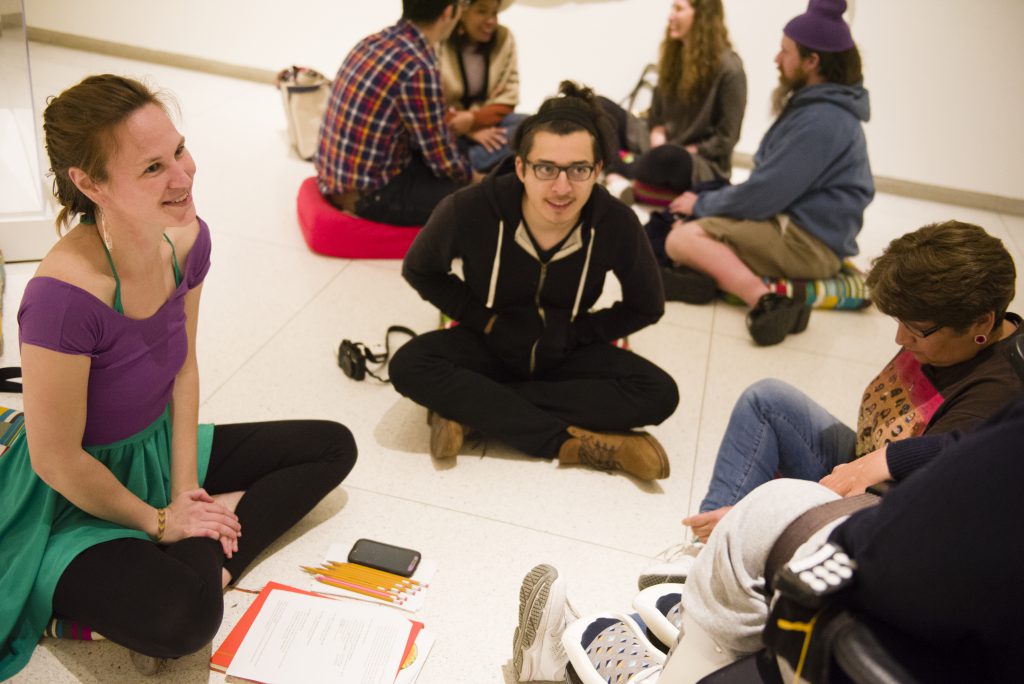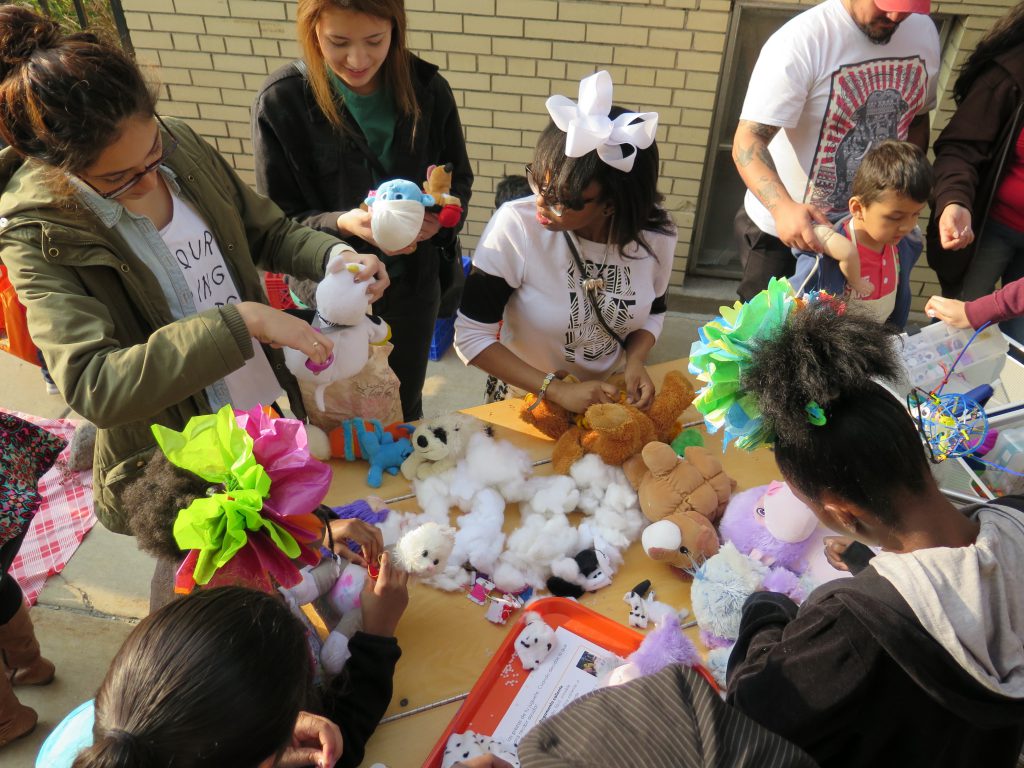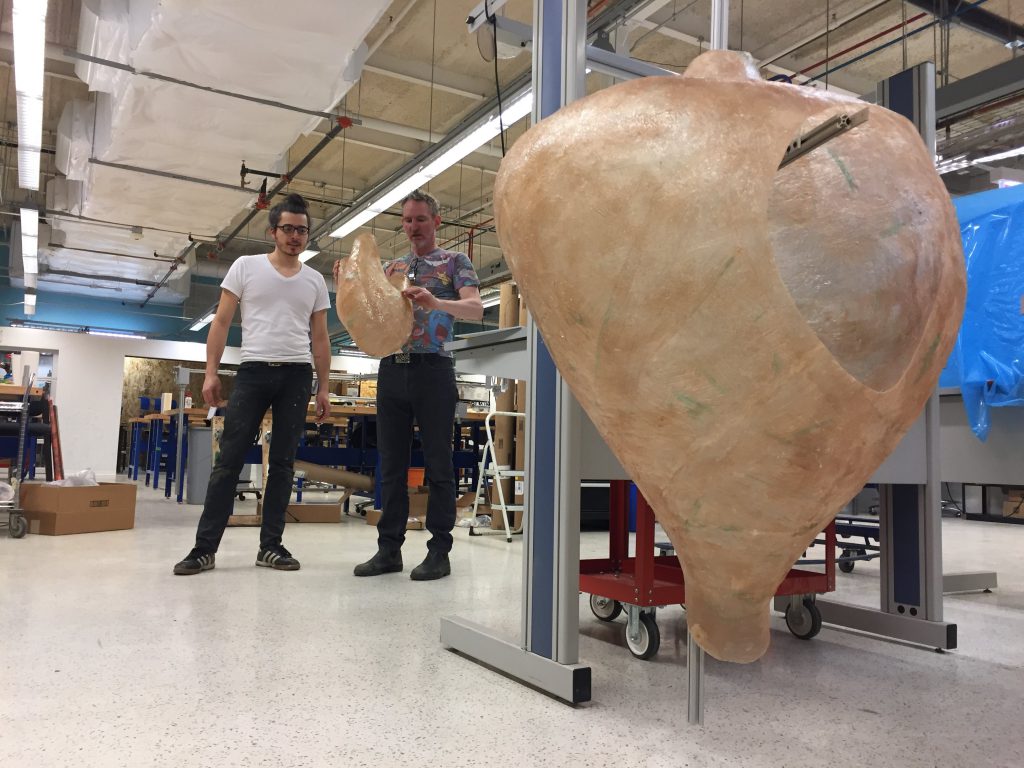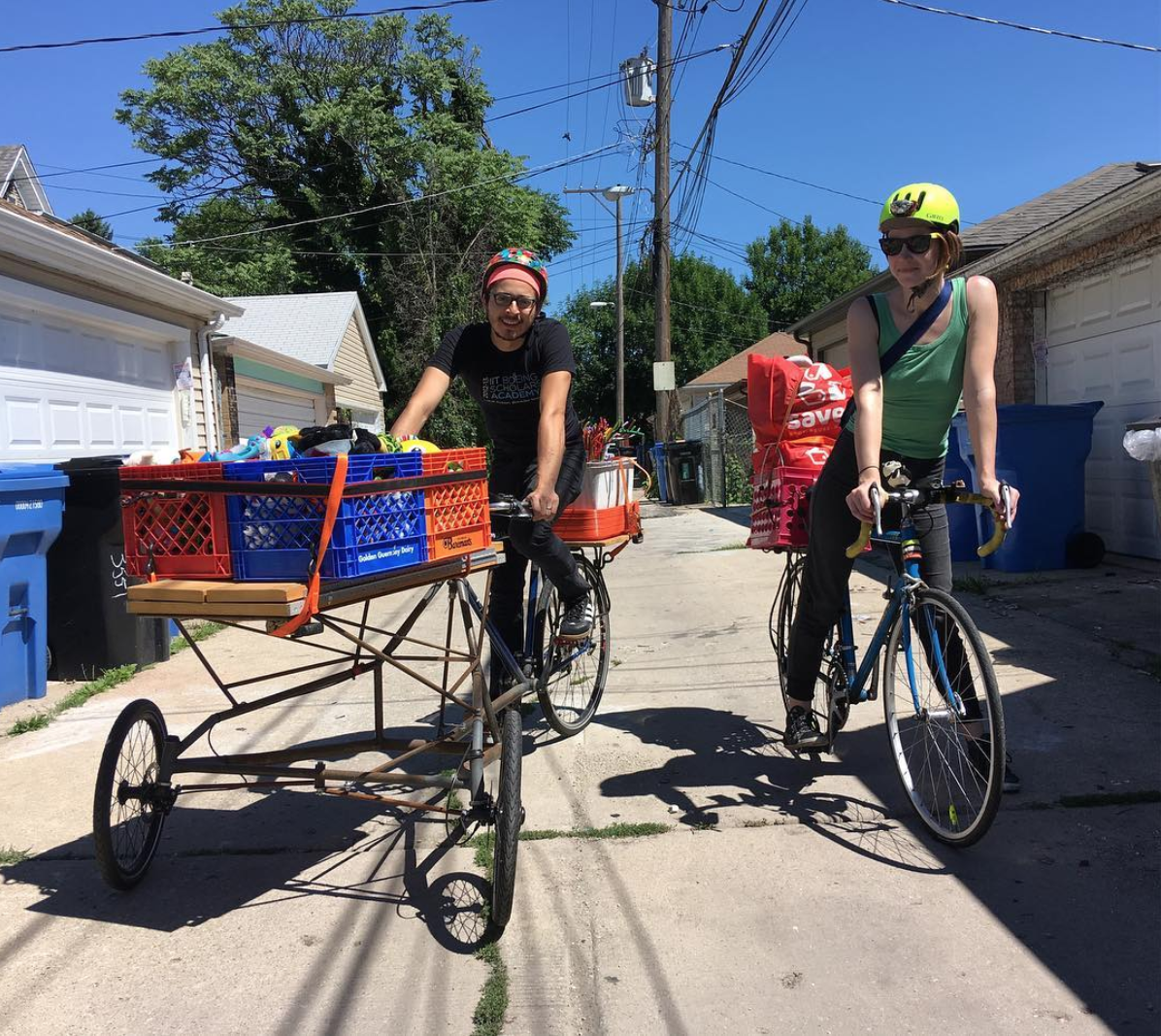As part of our Art + Love series, Marya Spont-Lemus and Andrés Lemus-Spont reflect on their experiences collaborating with one another and the ways in which their relationship has and continues to influence their individual practices.
On where it all started:
Marya Spont-Lemus: We met at Maria’s in Bridgeport, at a goodbye party for my co-worker. Though I liked my co-worker very much, I was only planning to go for a polite 15 minutes, and then continue on home to get work done on a Friday night.
Andrés Lemus-Spont: I was biking around and wanted to hang out with Marya’s co-worker, who was my friend from architecture school. At the party, I started talking only to my friend, but pretty soon I noticed Marya. At first I didn’t see her as much as sense her. She just had this beautiful glow that I’d never experienced.
M: I actually remember that you arrived right at 6 o’clock, because that’s when I’d been planning to leave. But something told me to stay—I saw your glow, too.
A: When I finally got the chance to approach Marya, I found her quietly playing this sort of game by herself. She was pushing around these beer tabs with a cocktail sword. We decided to take turns arranging the tabs and then the other person would guess what we were trying to express with that. Then the other person would create another arrangement that was the oblique of the last arrangement.
M: The people who knew us were so astonished and amused by whatever was happening between us that they started taking photos of us surreptitiously. So we actually have photos from the night we met showing us clearly engrossed in each other and ignoring everyone else.
A: That game was really such a big part of how I fell for Marya so quickly. It really showed me how her brain worked. It showed me how smart she was, her humor, and her values.
M: And, on my end, I was able to see things that I still value about you, like your playfulness, your willingness to experiment, just how clever you are. I felt like you were game for things. And it’s funny because the thought flashed through my mind that I could be with you for the rest of my life—which was otherwise so not something I was thinking about at that time.

On one another’s process and practice:
A: Marya’s practice takes a bunch of forms. Writing is probably the main one and I think that’s probably because it’s closest to what her true artistry is, which is how she thinks. I don’t know exactly what her brain is like but I feel like Marya is like a thinking machine. Unceasing in observing, cataloging, and analyzing the beauty, possibilities, and injustices in this world. Like when I think, most of my thoughts are like Instagram posts. You know, light observations on what I’m experiencing. When Marya thinks, it’s like opinions and objections and questions and contexts. Then her process of turning that into something is taking all those brain thoughts and putting it out on paper, creating 100 times more content than is necessary and then wrestling that down to an appropriate size. I think it’s laborious, it’s taxing, it’s filled with self loathing. It’s very aggressive. It’s like her doing battle with herself. I think she’s trying to approximate what’s in her brain with the constraints of the physical world.
One thing I really appreciate is her commitment to her work and the way she gives herself wholly to it even to her own physical detriment. That work ethic is something I really admire. It’s also really important in our relationship because we both do the same thing. Having a partner that can understand that desire to put all of ourselves into our work for a period of time is an important way in which we support each other.
M: As for you, of course you’re a designer, builder, and fabricator, as well as a teaching artist. You continue to amaze me with the things you are able to make—I’m convinced you can figure out how to make anything. One thing I admire about your work is how inextricable mentorship and social mission are from the objects and environments that you make and how you make those things.
But I also feel like it isn’t only the things that you physically make that make you an artist. I don’t think you go into your shop and say, ‘Now I’m turning on my artist brain.’ I feel like your artist brain is always on, and that experimenting and re-thinking and re-tooling is just how you go through the world.

I really appreciate your playfulness and your joy, and I feel like you don’t apologize for enjoying things. I also really love your criticality, and that you don’t hesitate to criticize things that should be criticized, or to be a hardass about things that one should be a hardass about. I think you have so much integrity and stand behind the things you believe in, even if it’s unpopular or other people disagree with you.
On collaborating with one another:
M: We’ve collaborated on videos and supported each other’s work in various ways, but our main and longest collaboration has been the FrankenToyMobile, through which we’ve been running free “FrankenToy”-making workshops in public spaces around Chicago since summer 2015. I think one could draw connections between the values of the FrankenToyMobile project and each of our values pretty easily, but the way the project manifests feels quite unique from our individual practices—it feels like a third thing. And, for me, the experience of the project is totally distinct from my writing. I’m not sitting alone in a room in a bubble of self-doubt, creating fictional characters and engaging abstract themes; we’re in a public space with maybe 50 small children grasping for our attention as we help them sew and glue and create toys that are the toys that they want to exist in the world. Amid that frenetic energy and communal making, the last thing I’m thinking about is myself or my writing. And I love that.
A: I also love the frenetic nature of our workshops. A big part of that project though is the work that we put into making those workshops happen. The planning and scheduling and decision-making to make those moments of creation even better. In those strategic moments, the FrankenToyMobile asks us to become one person, and meet in the middle. We complement and temper and encourage each other. It’s not “me and you” doing our work but “us” doing the work. We both bring our things to it but without either of us it wouldn’t be as good.
M: There are so many reasons why we created that project, but an unexpected by-product is that—in the summers, when we might have multiple workshops in a week—it’s sort of forced time for us to be together, planning, prepping, traveling around the city, and, ultimately, experiencing 2-3 hours of creative production with each other and other people at each event. By which I mean, the project has also proved itself to be a structure and excuse to spend time with each other and have fun together, as much as it is a structure and excuse to meet tons of people around the city and have fun with them and to create fun for them.
A: That makes me think of it as a sort of weekly couple’s teambuilding that our relationship definitely benefits from. Our FrankenToyMobile workshops are trials full of both frustration and joy that bring us closer together.
On sharing space:
M: In our apartment in McKinley Park, we each have a designated creative space that is our own. And I think that that is really important, not only because what our day-to-day work might look like is really different, but I think it’s helpful for my work, to be able to go into a room, however small, and close the door and be in a private place where I can tape up notes everywhere and it is about my work. I also love the beautiful desk that you designed and built for me, which feels like an ever-present vote of confidence in me and in my work.
I feel like you respect that when I go in my studio, if my door is closed, I am not to be disturbed for something frivolous. The fact that you understand those boundaries is meaningful to me, and it also helps me focus and get work done in the limited time that I have. Similarly, even though your shop is only a half-mile away, I don’t randomly drop in unannounced when you’re there doing your thing. I think it’s good for our relationship that we have separate spaces where we can each do that.

A: Being in close proximity to your work has shown me that who you are, the things you do, the people you do things with, all that is important. It is political, it matters, and it shouldn’t be done carelessly or thoughtlessly. It has impacted how I approach the way I move through this world.
On how their process and practice have been influenced by one another:
M: I’d say that one of the main ways you’ve influenced me is by making me a better person, as cheesy as it sounds. Knowing you has made me more kind—kind to others, kind to myself, kind as a mindset. Knowing you has made me more loving and more forgiving. In turn, that has helped me write better characters, because I have to love them, in all their complexities, for them to be real on the page. Knowing you has also helped me feel like I don’t need to apologize all the time—there’s a kind of spirit and confidence that I’ve gotten from spending time with you and from seeing how you operate in the world that has been really crucial to my even investing as much time as I have in the last few years in my creative work.
And not to mention the finances of being an artist. A big influence that we’ve probably had on each other is simply by supporting each other’s creative pursuits, either financially when we can or with the standing acknowledgement that this is a fundamental and essential part of who we are and we have to do it—and so then, because we have to do it, we have to financially figure it out.
A: Talking about finances makes me think about life choices too. Had I not met Marya I would not have realized the person I could become. I had a lot of notions of what the right way to go through life was: the things I should want, the person I should be, the kind of job I should have. Marya showed me the possibility for alternate values. My values can be my values and I don’t have to adopt society’s values. I wonder who I would be without you. I think I’d mostly be me, but I’d be me trying to be everyone else. Marya showed me that I could just be me.
M: I mean, it’s not easy to go through life, it’s not easy to live in this world, it’s not easy to make ends meet, it’s not easy to make art. And I’m told that it’s not easy to be in a relationship. But I feel like we get along so well and share values and visions to such an extent that, while all of that other stuff is hard, our relationship provides a core that enables me to feel like I can summon what I need to tackle all the other stuff.
…and another thing:
A: I never get tired of being with Marya. Not like being with her as a partner but literally sharing space together and sharing experiences. I don’t have that with anyone else.
M: I feel the same way. And if I’m going into my studio, it’s always at the expense of spending time with you. I’m going to make work.
_
This interview is part of the Art + Love series. More interviews can be read here.
Featured Image: Andrés and Marya on their bikes looking toward the camera. It’s a beautiful, sunny day and they are riding through an alley.



